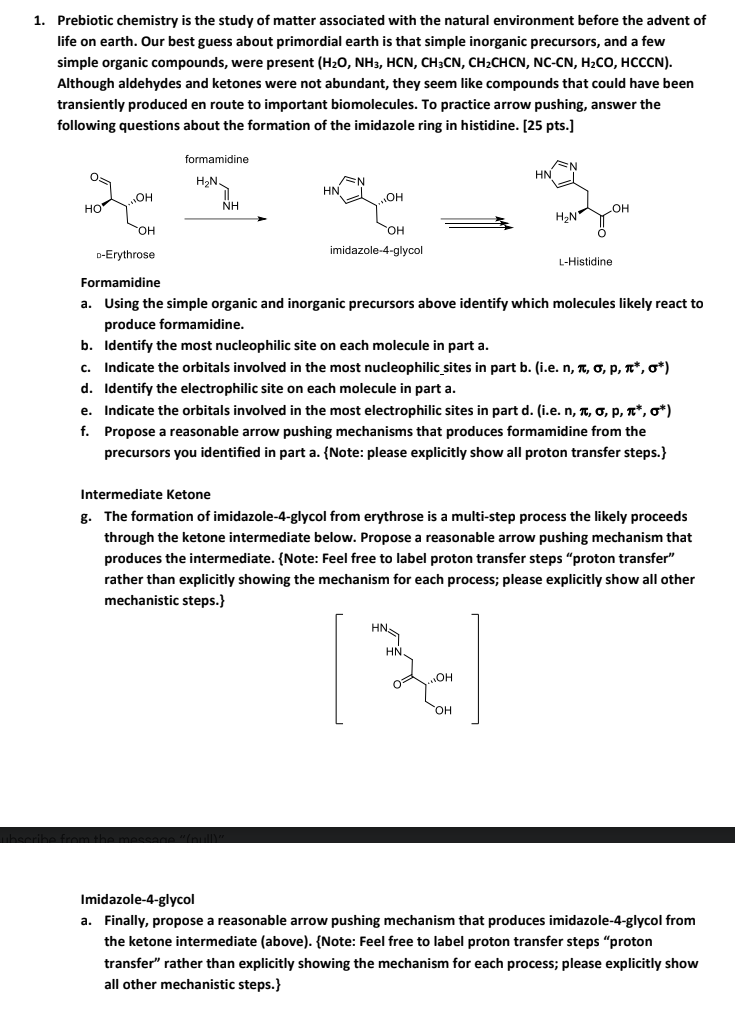
1. Prebiotic chemistry is the study of matter associated with the natural environment before the advent of life on earth. Our best guess about primordial earth is that simple inorganic precursors, and a few simple organic compounds, were present (H2O,NH3,HCN,CH3CN,CH2CHCN,NCCN,H2CO,HCCCN). Although aldehydes and ketones were not abundant, they seem like compounds that could have been transiently produced en route to important biomolecules. To practice arrow pushing, answer the following questions about the formation of the imidazole ring in histidine. [25 pts.] o-Erythrose imidazole-4-glycol L-Histidine Formamidine a. Using the simple organic and inorganic precursors above identify which molecules likely react to produce formamidine. b. Identify the most nucleophilic site on each molecule in part a. c. Indicate the orbitals involved in the most nucleophilic_sites in part b. (i.e. n,,,p,, ) d. Identify the electrophilic site on each molecule in part a. e. Indicate the orbitals involved in the most electrophilic sites in part d. (i.e. n,,,p,, ) f. Propose a reasonable arrow pushing mechanisms that produces formamidine from the precursors you identified in part a. \{Note: please explicitly show all proton transfer steps.\} Intermediate Ketone g. The formation of imidazole-4-glycol from erythrose is a multi-step process the likely proceeds through the ketone intermediate below. Propose a reasonable arrow pushing mechanism that produces the intermediate. \{Note: Feel free to label proton transfer steps "proton transfer" rather than explicitly showing the mechanism for each process; please explicitly show all other mechanistic steps. } Imidazole-4-glycol a. Finally, propose a reasonable arrow pushing mechanism that produces imidazole-4-glycol from the ketone intermediate (above). \{Note: Feel free to label proton transfer steps "proton transfer" rather than explicitly showing the mechanism for each process; please explicitly show all other mechanistic steps.\} 1. Prebiotic chemistry is the study of matter associated with the natural environment before the advent of life on earth. Our best guess about primordial earth is that simple inorganic precursors, and a few simple organic compounds, were present (H2O,NH3,HCN,CH3CN,CH2CHCN,NCCN,H2CO,HCCCN). Although aldehydes and ketones were not abundant, they seem like compounds that could have been transiently produced en route to important biomolecules. To practice arrow pushing, answer the following questions about the formation of the imidazole ring in histidine. [25 pts.] o-Erythrose imidazole-4-glycol L-Histidine Formamidine a. Using the simple organic and inorganic precursors above identify which molecules likely react to produce formamidine. b. Identify the most nucleophilic site on each molecule in part a. c. Indicate the orbitals involved in the most nucleophilic_sites in part b. (i.e. n,,,p,, ) d. Identify the electrophilic site on each molecule in part a. e. Indicate the orbitals involved in the most electrophilic sites in part d. (i.e. n,,,p,, ) f. Propose a reasonable arrow pushing mechanisms that produces formamidine from the precursors you identified in part a. \{Note: please explicitly show all proton transfer steps.\} Intermediate Ketone g. The formation of imidazole-4-glycol from erythrose is a multi-step process the likely proceeds through the ketone intermediate below. Propose a reasonable arrow pushing mechanism that produces the intermediate. \{Note: Feel free to label proton transfer steps "proton transfer" rather than explicitly showing the mechanism for each process; please explicitly show all other mechanistic steps. } Imidazole-4-glycol a. Finally, propose a reasonable arrow pushing mechanism that produces imidazole-4-glycol from the ketone intermediate (above). \{Note: Feel free to label proton transfer steps "proton transfer" rather than explicitly showing the mechanism for each process; please explicitly show all other mechanistic steps.\}







